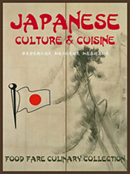|
Contents:
More:
E-book edition of "Japanese Culture & Cuisine" >
|
Sake
Sake is an alcoholic beverage made from rice. It is believed to enhance a meal, less filling then beer and with a mellower aftertaste than wine. HISTORY The first known mention of sake in history came in the Book of Wei in the third century. It was also referenced in Japan's first written history, Kojiki ("Record of Ancient Matters"), in the year 712. Temples and shrines began to brew sake during the 10th century, and then held monopoly of production for the next five hundred years. Distillation was introduced in the 16th century, after which the brew was sold at common markets. Government taxation forced the disbandment of many of sake breweries after 1868. Most of the remaining breweries were operated by wealthy landowners. In 1904-05, the government of Japan banned home-brewing in order to increase their tax coffers, a law which is still in effect today. However, sake production in Japan has declined over the last century. There are now only about 1,225 operating sake breweries in-country (2015 estimate from the National Tax Administration). Despite the decline, sake is still an important part of Japanese culture. They celebrate the brew by marking its significance on World Sake Day (October 1st) every year. BREWING SAKE
The process of rendering sake "mash" starts by injecting rice portions with a mold known as koji. Fungus growth takes about two days, after which the starter mash (shubo) is prepared. The koji rice, water and yeast are blended together, with lactic acid included to prevent the formation of bacteria. Freshly-steamed rice is also added to the mix, and then allowed to rest for about two weeks. Later, more portions of freshly-steamed rice are added to the mixture once a day for up to three days. This state of mash is known as moromi, which is massive after the many additions of fresh rice. The moromi will be allowed to ferment for up to six weeks. Sake is produced by pressing the moromi after fermentation. The pressed sake is allowed to rest, and then diluted with water before it is bottled for sale. The end result of the brewing process brings two commonly-known varieties of sake: Futsu-shu (the equivalent of table wine) and Tokutei meisho-shu (premium sake). There are several rice-bases brews similar to sake available in Japan, including Amazake (sweet, non-alcoholic), Chuak (rice beer), Jizake (locally brewed), Kuroshu (made from unpolished rice), Shochu (distilled from barley, brown sugar, buckwheat, chestnut, sweet potatoes or rice) and Teiseihaku-shu (made from a higher polishing ration than standard sake), among others.
The job title of a professional sake brewer is "Toji." In Japan, Toji's are highly respected, regarded to be in the same artistic stratosphere as much-admired painters and musicians. DRINKING SAKE Sake is usually warmed before drinking, which deepens the taste. The best way to heat sake is by placing the sake bottle into a pot of hot water, and then heating to the desired temperature. Never boil sake. It is recommended that sake be consumed slowly by taking small mouthfuls in a small glass. Sake can also be used with cooking, much in the same way wine is. Sake Temperature Index & Accessories
Tradition Sake is often consumed during Japanese rituals, such as Shinto ceremonies. One of the most common rituals is known as Kagami Biraki ("Opening the Mirror"), which entails opening a cask of sake at a celebratory event. The celebration sake (iwai-zake) is given freely to those attending the event. Similar to the practice of breaking bread, Kagami Biraki is often undertaken at sporting events, weddings, the launch of a new business or during the New Year holiday. Spicy sake, known as Toso, is commonly used to bring in the New Year. By drinking Toso, it is believed the previous year's ills will be washed away in order to begin anew in hopes of a better - and longer - life. Toso is a rather medicinal mix of sake, bellflower, cinnamon, ginger and pepper, among other herbs and spices.
|





 Joukan:
Hot sake (50 degrees).
Joukan:
Hot sake (50 degrees).